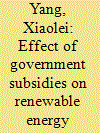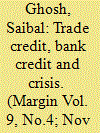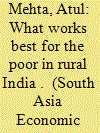|
|
|
Sort Order |
|
|
|
Items / Page
|
|
|
|
|
|
|
| Srl | Item |
| 1 |
ID:
167014


|
|
|
|
|
| Summary/Abstract |
By considering 92 renewable energy listed enterprises in China between 2007 and 2016 as sample, this paper constructs a panel threshold effect model to investigate the threshold effect of government subsidies on renewable energy investment and further explores the effects and differences regarding government subsidy types and enterprise size on the threshold effect. The results show that, first, government subsidies have a positive threshold effect on renewable energy investment of China. When energy consumption intensity and bank credit are greater and the level of economic development is less than the threshold value, the contribution of government subsidies to renewable energy investment is significantly enhanced. Second, monetary subsidies and tax incentive policies can promote renewable energy investment, but the effect of tax incentives is more significant. Third, government subsidies are the main force supporting the development of medium-, small-, and micro-sized renewable energy enterprises. On the basis of these results, the Chinese government should strengthen policy support in those areas with high economic costs of energy transition, encourage the investment in renewable energy in large-sized enterprises, play a policy-guiding role, and focus on strengthening subsidies for medium-, small-, and micro-sized enterprises.
|
|
|
|
|
|
|
|
|
|
|
|
|
|
|
|
| 2 |
ID:
142015


|
|
|
|
|
| Summary/Abstract |
Employing data on an extended sample of manufacturing firms during 1993–2012, the article studies the inter-linkage between trade credit and bank credit and how it evolved during the crisis. Accordingly, we first discuss the relevance of a trade-credit channel in India and subsequently, explore the interplay between these two financing forms. The analysis provides some evidence in favour of a trade-credit channel in India. More importantly, the findings indicate that bank credit and trade credit are complementary, although there was a differential impact on accounts payable (demand) and accounts receivables (supply) during the crisis.
|
|
|
|
|
|
|
|
|
|
|
|
|
|
|
|
| 3 |
ID:
157064


|
|
|
|
|
| Summary/Abstract |
Financial sector development serves poor directly through poverty-lending approach or financial systems approach. Robinson (2001) questions the appropriateness of poverty-lending approach for the extremely poor and supports the financial systems approach for providing a poverty alleviation toolbox to serve the poor at various levels. The present study attempts to assess the effectiveness of the two lending approaches and comments on the appropriateness of the same for the poor and the poorest of the poor in rural India using state-wise annual data from 1999–2000 to 2011–2012. We conduct a panel data analysis for a sample of 15 major Indian states and provide an empirical evidence for the effect of various poverty alleviation tools on the poor and the poorest of the poor in rural India. The study partially supports the use of tools suggested by Robinson.
|
|
|
|
|
|
|
|
|
|
|
|
|
|
|
|
| 4 |
ID:
169159


|
|
|
|
|
| Summary/Abstract |
In recent years, as China has grappled with rising debt and broad economic restructure, the prevalence of zombie firms has become a critical problem. This paper provides a theoretical framework illustrating the rationale behind the occurrence of zombie firms from the perspective of banks. We develop differential equations to model a bank's expectation and the ex ante estimate that underlies its decision to refinance an insolvent borrower. An optimistic expectation is essential in zombie lending and is intrinsic to the countercyclical pattern of zombie firms. Our model also predicts that debt can build up to an unsustainable level if recovery of profitability is sluggish or the initial debt burden is too high. Examining the Chinese experience of zombie firms over 2007–2017, this paper highlights two findings. First, the share of zombie firms among Shanghai and Shenzhen A‐share listed companies demonstrates a countercyclical pattern. Second, the positive correlation between zombie share and debt accumulation across manufacturing sectors sheds light on the link between zombie firms and the rising corporate debt in China. To deal with the “zombie” problem, the government should carefully weigh its policies to avoid further distortions because the occurrence of zombie firms may be inevitable and impossible to eliminate.
|
|
|
|
|
|
|
|
|
|
|
|
|
|
|
|
|
|
|
|
|